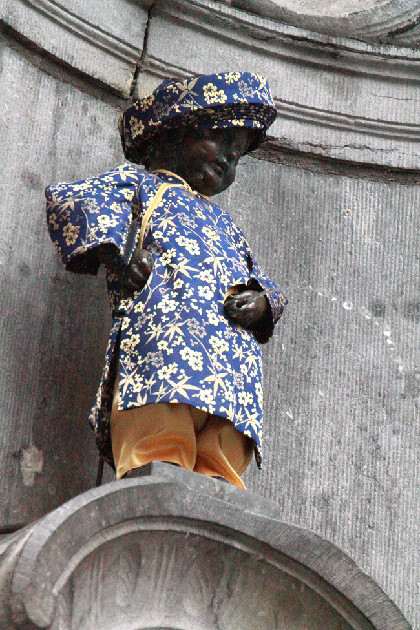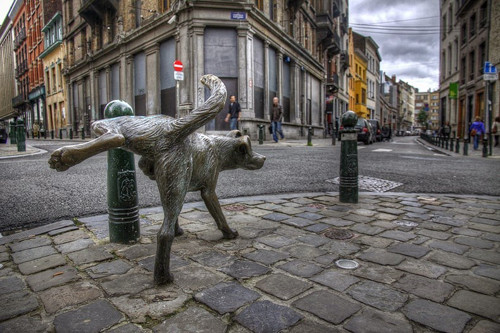Manneken Pis - The story of the little boy peeing in Brussels

- My first place I want to visit in Brussels
When I arrived in Belgium, the first place I wanted to visit would be the famous statue of the little boy, the icon of Brussels. It was a cold and rainy day, Mrs. Hoa was my mother's student, and she led me to visit the famous Brussels symbol, Manneken Pis, which translates as a boy who is peeing. I was fortunate enough to visit this statue and the mermaid in Copenhagen, perhaps the only two statues chosen to symbolize the capitals of a European country.
Before coming here I was warned that this statue is small, but it is still smaller than my thoughts. The 61cm tall statue, smaller than the real kid, was nestled in a literally square fence, literally the most iconic icon I've ever seen. If you think the turtle baby is not known what word capacitance to describe the volume of this statue anymore. Actually I did not find it too anything special, but always nibbling people squeezed foot with this boy.
Moreover, Ms Hoa told me that this statue has a separate wardrobe, sometimes people will get a new suit for him, sometimes he is dressing like the mummy, sometimes like a soldiers, he is always staying there as well as rain and sunshine, as well as the rain on the bare shaft, local people do not to compensate for the little boy in the middle of the road that is always wearing clothes.
-
The location of the manneken Pis
Near the Grand Place on Rue de l 'Etuve 31 (Lievevrouwbroersstraat 31, 1000 Brussels, Belgium), the Manneken Pis is a small bronze monument 61 centimeters tall. This is the work of master sculptor Jérome Duquesnoy was completed in 1619. But in 1817 was replaced copper material.
This statue may not have been considered a masterpiece of art, but the way in which locals handed down legends about it, as well as the festivities with the presence of the statue made me feel very fond of it.
The statue of the little boy has become the symbol of the city of Brussels.
-
Story around Manneken Pis Statue

Manneken is wearing Vietnamese Traditional Dress called Ao Dai in Vietnam.
There are many stories surrounding this statue and many argue about the reason the statue was erected. It is said that a dad traveling to Brussels lost his son, and after receiving the enthusiastic help of the locals to find the boy, he donated the statue as a dish gifts instead of thanks for them.
Although there are many variants of the boy's "profile", I find the best sounding story is the story of patriotism. That story is related to my beloved Spain.
-
Mrs. Hoa and her deep knowledge of Belgium Culture and History.
Anyway, I felt so lucky to meet Mrs. Hoa, she is my mother's former student, even though she was a student when my mother was a literature teacher 23 years ago, at that time I was not born yet. However, she has been married to Belgium guy and she has been living in Belgium for 10 years, so she understands Belgian culture and history a lot.
Moreover, She told me that in October she would take the Belgian Nationality Exam so she took the time to learn French and learn about the Belgian cultural history, especially about Brussels, the city she and her husband are living in. So I could say that I had this wonderful guide in Brussels, the heart of Europe. That's why I heard wonderful stories about this little boy.
- Manneken Boy and the story of the war between Spain and Belgium.
In the 14th century, the relationship between Belgium and Spain was not good. Spain was a powerful country in Europe, bordering France. Belgium also has borders with France, but due to its bad relationship with Spain, Belgium is often associated with France to confront Spain.
Then, Spain sent naval and army troops to attack Belgium, then they continued sending more troops to Belgium. In only two short months, Spain has occupied Belgium territory including the Belgian capital of Brussels. Belgium was forced to sign the Spanish surrender agreement and within 40 years was not allowed to ally France, meeting this condition; Spain would withdraw its troops from Belgium. After a few months of negotiations, Spain finally retreated to the start. But the moment Spain withdrew from Brussels, they again came up with a bad intention: to use explosives to destroy Brussels.
Spanish soldiers masqueraded as Belgians and secretly buried hundreds of tons of explosives buried in many parts of Brussels. All of these explosives eventually led to a detonator. Then the Spanish army almost withdrew from Brussels only some volunteer soldiers remained "donated" to the explosion.
-
The boy who has saved Brussels
When the wire to spark the explosion was completed, then suddenly, from where, a little boy ran through, standing on the burnt fire slowly. Immediately, the boil was wet and could not be burned.
Later, the Belgian army discovered, raised the boy raised and the people of Brussels, especially praised the boy saved the city of Brussels, even the whole of Belgium. Why say he saved the whole country?
Because, at that time, Belgium was extremely small, and was not a sovereign state, still subject to French domination. At that time, Belgium had more than 1, 000, 000 inhabitants, the population was concentrated in Brussels, if Brussels was destroyed, Belgium would collapse. Then to commemorate this event, the city has built this bronze statue. The boy is Julien Dillens. Many people after hearing the story of this little boy feel this is a fairy tale. But this is not true, this is a true story in history!
The records of Belgium and Spain are recorded in this passage. Both countries recorded the Spanish process of attacking Belgium, the withdrawal process and the boy had shut off the detonator. Records in these two countries match
-
Manneken Pis Statue with the celebration
Mrs. Hoa told me that the people of Brussels are so good at tourism so they do not simply want to look at this cute statue and introduce it to international friends, to increase the number of tourists and make money from tourism... Not every "ceiling", people in Brussels also want to bring the image of the baby to the world. So, on some occasions, they turned the Manneken Pis statue into a special character in the city's events and festivals. It even has a suit that suits every occasion.
For example, a few years ago, Mrs. Hoa pledges that one day she went through the Manneken Pis and discovered they were wearing a shirt for the boy so that he looked like Sinterklaas, there was another time they turned him into a rock star. In addition, I was surprised to hear that the "Wardrobe" of the Manneken Pis Statue includes more than 800 costumes, from Santa Claus to the national costumes of countries around the world. The statue is changed to dress about 30 times a year. On special occasions, the Manneken Pis statue spits out beer with a variety of flavors, serving locals as well as tourists, while the band uses brass instruments and percussion playing around.
-
Other stories about Manneken Pis statue
In addition, I found out and learned about another legends related to the story of the old witch of the Rue de l'Etuve who decided to take a heavy punishment for a boy who dared to pee in front of her house, that is to turn the boy into a stone statue. Fortunately, at that moment, a good old man appeared with a statue quite similar to the boy, so when the sorceress prepared to vent the curse down the boy, the old man quickly grabbed the boy and placed statue in that position.
Finally, I have found this less common story involved a little boy named Julien. One time, Julien went to the door of a hermit's house. When he heard the sound of running water, the old man shouted and rushed out of the house. Upon seeing Julien, the hermit immediately made him turn into a statue and repeatedly cursed his behavior. However, because of this scare, many changed the ending, adding that the father employed a different statue to resemble Julien and when the statue was replaced. The boy was "peeing" then the boy was made.
Other interesting " peeing family" statues
Jeanneke Pis - she is peeing

-
Jeanneke Pis
Jeanneke Pis less famous than Manneken Pis, however, when coming to Brussels, you should definitely visit all three standing statues. Being regarded as the little sister of Manneken, Jeanneke is a half-meter tall statue depicting the girl sitting in "solving sadness", her hair tied to her side, her face raised and fresh. This statue is hidden in an alley just outside Manneken Pis, protected by an iron fence outside. So I was not able to visit.

- Zinneke Pis - The dog is peeing
I felt regretful to not visit Zinneke Pis which is the last statue in the "peeing family" in Brussels. I knew this statue depicted a dog, carved in bronze and located on the corner of Rue des Chartreaux and Rue de Vieux-Marche. However as I had a little time in Brussels so I did not visit this statue.
To conclude
After visiting Brugge, I realized that Manneken Pis was famous throughout Belgium, the image of Manneken Pis on the streets today appears in many places in Belgium, even I heard there are also girls who are Honey, with the dog too. In restaurants, hotels, people often use this fat, naive boy. So they put in the production of souvenirs such as beer, key chains, figurines, ... I also bought myself a small Manneken Pis as a small memory of the visit to Brussels
Photo gallery
Content available in other languages
Want to have your own Erasmus blog?
If you are experiencing living abroad, you're an avid traveller or want to promote the city where you live... create your own blog and share your adventures!
I want to create my Erasmus blog! →



















Comments (2 comments)
Good!
Good!